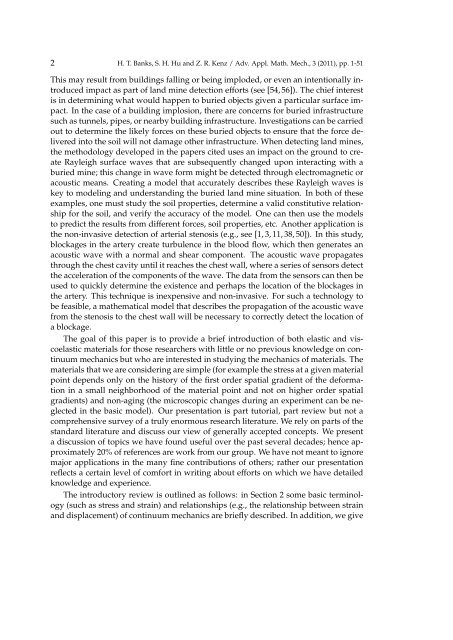A Brief Review of Elasticity and Viscoelasticity for Solids 1 Introduction
A Brief Review of Elasticity and Viscoelasticity for Solids 1 Introduction
A Brief Review of Elasticity and Viscoelasticity for Solids 1 Introduction
You also want an ePaper? Increase the reach of your titles
YUMPU automatically turns print PDFs into web optimized ePapers that Google loves.
2 H. T. Banks, S. H. Hu <strong>and</strong> Z. R. Kenz / Adv. Appl. Math. Mech., 3 (2011), pp. 1-51<br />
This may result from buildings falling or being imploded, or even an intentionally introduced<br />
impact as part <strong>of</strong> l<strong>and</strong> mine detection ef<strong>for</strong>ts (see [54, 56]). The chief interest<br />
is in determining what would happen to buried objects given a particular surface impact.<br />
In the case <strong>of</strong> a building implosion, there are concerns <strong>for</strong> buried infrastructure<br />
such as tunnels, pipes, or nearby building infrastructure. Investigations can be carried<br />
out to determine the likely <strong>for</strong>ces on these buried objects to ensure that the <strong>for</strong>ce delivered<br />
into the soil will not damage other infrastructure. When detecting l<strong>and</strong> mines,<br />
the methodology developed in the papers cited uses an impact on the ground to create<br />
Rayleigh surface waves that are subsequently changed upon interacting with a<br />
buried mine; this change in wave <strong>for</strong>m might be detected through electromagnetic or<br />
acoustic means. Creating a model that accurately describes these Rayleigh waves is<br />
key to modeling <strong>and</strong> underst<strong>and</strong>ing the buried l<strong>and</strong> mine situation. In both <strong>of</strong> these<br />
examples, one must study the soil properties, determine a valid constitutive relationship<br />
<strong>for</strong> the soil, <strong>and</strong> verify the accuracy <strong>of</strong> the model. One can then use the models<br />
to predict the results from different <strong>for</strong>ces, soil properties, etc. Another application is<br />
the non-invasive detection <strong>of</strong> arterial stenosis (e.g., see [1, 3, 11, 38, 50]). In this study,<br />
blockages in the artery create turbulence in the blood flow, which then generates an<br />
acoustic wave with a normal <strong>and</strong> shear component. The acoustic wave propagates<br />
through the chest cavity until it reaches the chest wall, where a series <strong>of</strong> sensors detect<br />
the acceleration <strong>of</strong> the components <strong>of</strong> the wave. The data from the sensors can then be<br />
used to quickly determine the existence <strong>and</strong> perhaps the location <strong>of</strong> the blockages in<br />
the artery. This technique is inexpensive <strong>and</strong> non-invasive. For such a technology to<br />
be feasible, a mathematical model that describes the propagation <strong>of</strong> the acoustic wave<br />
from the stenosis to the chest wall will be necessary to correctly detect the location <strong>of</strong><br />
a blockage.<br />
The goal <strong>of</strong> this paper is to provide a brief introduction <strong>of</strong> both elastic <strong>and</strong> viscoelastic<br />
materials <strong>for</strong> those researchers with little or no previous knowledge on continuum<br />
mechanics but who are interested in studying the mechanics <strong>of</strong> materials. The<br />
materials that we are considering are simple (<strong>for</strong> example the stress at a given material<br />
point depends only on the history <strong>of</strong> the first order spatial gradient <strong>of</strong> the de<strong>for</strong>mation<br />
in a small neighborhood <strong>of</strong> the material point <strong>and</strong> not on higher order spatial<br />
gradients) <strong>and</strong> non-aging (the microscopic changes during an experiment can be neglected<br />
in the basic model). Our presentation is part tutorial, part review but not a<br />
comprehensive survey <strong>of</strong> a truly enormous research literature. We rely on parts <strong>of</strong> the<br />
st<strong>and</strong>ard literature <strong>and</strong> discuss our view <strong>of</strong> generally accepted concepts. We present<br />
a discussion <strong>of</strong> topics we have found useful over the past several decades; hence approximately<br />
20% <strong>of</strong> references are work from our group. We have not meant to ignore<br />
major applications in the many fine contributions <strong>of</strong> others; rather our presentation<br />
reflects a certain level <strong>of</strong> com<strong>for</strong>t in writing about ef<strong>for</strong>ts on which we have detailed<br />
knowledge <strong>and</strong> experience.<br />
The introductory review is outlined as follows: in Section 2 some basic terminology<br />
(such as stress <strong>and</strong> strain) <strong>and</strong> relationships (e.g., the relationship between strain<br />
<strong>and</strong> displacement) <strong>of</strong> continuum mechanics are briefly described. In addition, we give

















